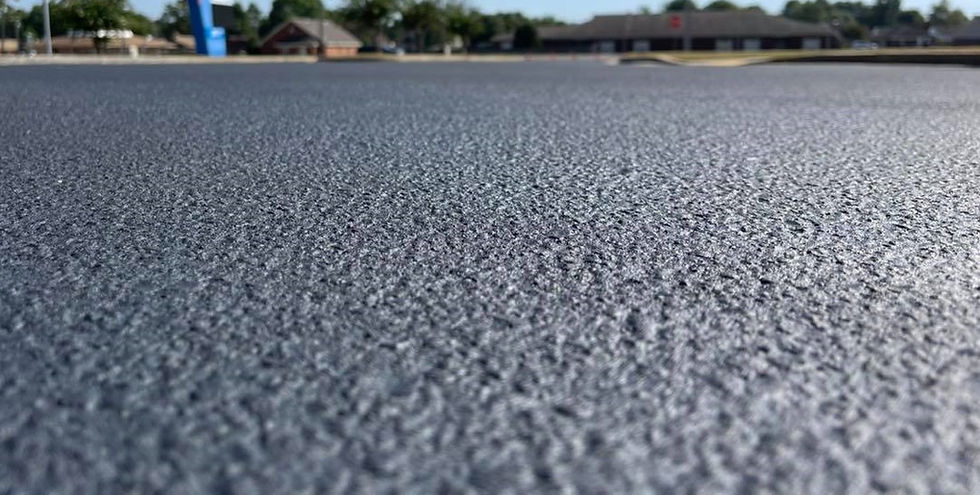The Science Behind Sealcoating: How It Protects and Extends Pavement Life
- Armor Asphalt
- Feb 27
- 3 min read

Asphalt pavement is a critical investment for homeowners, businesses, and municipalities, providing durable and reliable surfaces for roads, driveways, and parking lots. However, exposure to weather, traffic, and chemical spills accelerates asphalt deterioration over time. This is where sealcoating plays a crucial role by forming a protective barrier that shields asphalt from oxidation, moisture, and chemical damage, thereby preserving its integrity and extending its lifespan. By understanding the science behind sealcoating, property owners can make informed decisions about maintaining their asphalt surfaces effectively. And, when properly done, it is evident how sealcoating protects and extends pavement life.
The Composition of Asphalt and Its Vulnerabilities
Asphalt is primarily composed of aggregates (such as crushed stone, sand, and gravel) and a binding agent called bitumen. While bitumen provides flexibility and adhesion, it is highly susceptible to oxidation, UV degradation, and chemical exposure. Over time, these factors cause asphalt to become brittle, leading to cracks, potholes, and structural failures.
How Sealcoating Works
Sealcoating is a protective layer that shields asphalt from oxidation, UV exposure, moisture, and chemical spills. It typically consists of a mixture of refined coal tar or asphalt-based emulsions, water, mineral fillers, and additives. When properly applied, sealcoating forms a barrier that prevents oxidation, moisture penetration, and surface wear.
1. Protection Against Oxidation
Oxidation occurs when asphalt is exposed to oxygen and UV rays, causing the bitumen to harden and lose its flexibility. This leads to surface cracking and premature aging. Sealcoating contains UV-resistant components that block harmful rays and slow down the oxidation process, preserving the asphalt’s integrity.
2. Moisture and Water Resistance
Water is one of asphalt’s greatest enemies. When it seeps into cracks and reaches the sub-base, it weakens the foundation, leading to potholes and structural failures. Sealcoating creates a waterproof barrier that prevents water from penetrating the surface, reducing the risk of erosion and freeze-thaw damage.
3. Chemical and Oil Spill Protection
Parking lots and driveways are often exposed to gasoline, oil, and other chemicals that can break down asphalt binders. The sealcoat layer acts as a protective shield, preventing these substances from penetrating the surface and causing deterioration. This chemical resistance extends the life of the pavement and reduces maintenance costs.
4. Improved Surface Durability and Aesthetic Appeal
Beyond protection, sealcoating enhances the appearance of asphalt by restoring its deep black color, giving it a fresh, well-maintained look. It also creates a smooth, uniform surface that reduces friction and minimizes wear from traffic.
The Science of Sealcoat Application
Proper sealcoating requires specific conditions to ensure optimal adhesion and performance. Here are some key scientific considerations:
Temperature and Humidity: Ideal application conditions include temperatures above 50°F (10°C) and low humidity to allow for proper curing.
Curing Time: Sealcoating needs 24 to 48 hours to dry fully for maximum durability.
Layering Technique: Applying two thin coats rather than one thick coat ensures even coverage and prevents premature peeling or cracking. Thin coats adhere better to the surface and allow for more even curing, reducing the risk of inconsistencies and ensuring long-term durability.
Additives and Enhancements: Modern sealcoating formulations include polymer additives and sand that improve elasticity, slip resistance, and longevity.
Long-Term Benefits of Sealcoating
Regular sealcoating, applied every 2-3 years, can extend pavement life by up to 50%, significantly reducing repair and replacement costs. It is an essential part of any asphalt maintenance strategy, preserving the surface’s structural integrity and aesthetic appeal.
Final Thoughts on Sealcoating
The science behind sealcoating demonstrates its effectiveness in protecting asphalt from environmental and chemical damage. By acting as a barrier against oxidation, moisture, and chemicals, sealcoating extends pavement life and minimizes costly repairs. Routine sealcoating enhances durability and preserves the visual appeal of asphalt. This makes it a smart and cost-effective solution for long-term pavement maintenance.







Comments